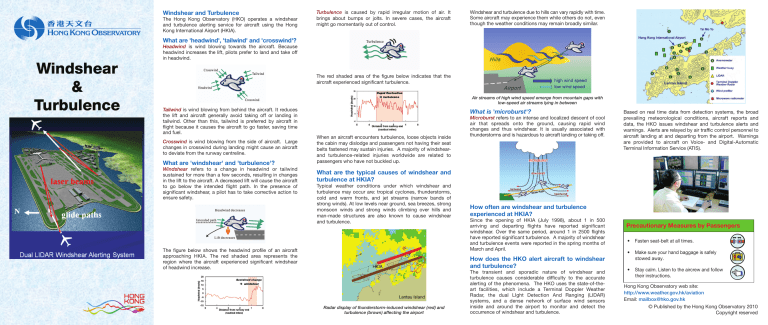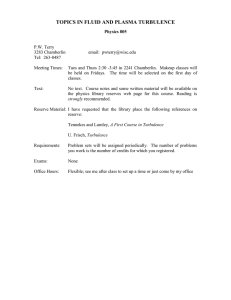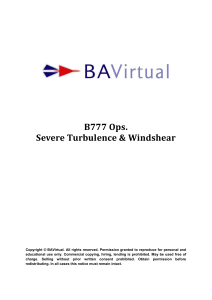
Windshear and Turbulence The Hong Kong Observatory (HKO) operates a windshear and turbulence alerting service for aircraft using the Hong Kong International Airport (HKIA). Turbulence is caused by rapid irregular motion of air. It brings about bumps or jolts. In severe cases, the aircraft might go momentarily out of control. Windshear and turbulence due to hills can vary rapidly with time. Some aircraft may experience them while others do not, even though the weather conditions may remain broadly similar. What are 'headwind', 'tailwind' and 'crosswind'? Headwind is wind blowing towards the aircraft. Because headwind increases the lift, pilots prefer to land and take off in headwind. The red shaded area of the figure below indicates that the aircraft experienced significant turbulence. Air streams of high wind speed emerge from mountain gaps with low-speed air streams lying in between Tailwind is wind blowing from behind the aircraft. It reduces the lift and aircraft generally avoid taking off or landing in tailwind. Other than this, tailwind is preferred by aircraft in flight because it causes the aircraft to go faster, saving time and fuel. Crosswind is wind blowing from the side of aircraft. Large changes in crosswind during landing might cause an aircraft to deviate from the runway centreline. What are 'windshear' and 'turbulence'? Windshear refers to a change in headwind or tailwind sustained for more than a few seconds, resulting in changes in the lift to the aircraft. A decreased lift will cause the aircraft to go below the intended flight path. In the presence of significant windshear, a pilot has to take corrective action to ensure safety. What is 'microburst'? When an aircraft encounters turbulence, loose objects inside the cabin may dislodge and passengers not having their seat belts fastened may sustain injuries. A majority of windshearand turbulence-related injuries worldwide are related to passengers who have not buckled up. Microburst refers to an intense and localized descent of cool air that spreads onto the ground, causing rapid wind changes and thus windshear. It is usually associated with thunderstorms and is hazardous to aircraft landing or taking off. Based on real time data from detection systems, the broad prevailing meteorological conditions, aircraft reports and data, the HKO issues windshear and turbulence alerts and warnings. Alerts are relayed by air traffic control personnel to aircraft landing at and departing from the airport. Warnings are provided to aircraft on Voice- and Digital-Automatic Terminal Information Service (ATIS). What are the typical causes of windshear and turbulence at HKIA? Typical weather conditions under which windshear and turbulence may occur are: tropical cyclones, thunderstorms, cold and warm fronts, and jet streams (narrow bands of strong winds). At low levels near ground, sea breezes, strong monsoon winds and strong winds climbing over hills and man-made structures are also known to cause windshear and turbulence. The figure below shows the headwind profile of an aircraft approaching HKIA. The red shaded area represents the region where the aircraft experienced significant windshear of headwind increase. How often are windshear and turbulence experienced at HKIA? Since the opening of HKIA (July 1998), about 1 in 500 arriving and departing flights have reported significant windshear. Over the same period, around 1 in 2500 flights have reported significant turbulence. A majority of windshear and turbulence events were reported in the spring months of March and April. How does the HKO alert aircraft to windshear and turbulence? Radar display of thunderstorm-induced windshear (red) and turbulence (brown) affecting the airport The transient and sporadic nature of windshear and turbulence causes considerable difficulty to the accurate alerting of the phenomena. The HKO uses the state-of-theart facilities, which include a Terminal Doppler Weather Radar, the dual LIght Detection And Ranging (LIDAR) systems, and a dense network of surface wind sensors inside and around the airport to monitor and detect the occurrence of windshear and turbulence. Precautionary Measures by Passengers • Fasten seat-belt at all times. • Make sure your hand baggage is safely stowed away. • Stay calm. Listen to the aircrew and follow their instructions. Hong Kong Observatory web site: http://www.weather.gov.hk/aviation Email: mailbox@hko.gov.hk © Published by the Hong Kong Observatory 2010 Copyright reserved


